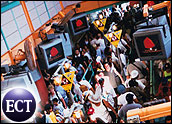
Large software developers and end users have softened their former staunch insistence that software had to be either purchased from an external vendor or created in-house.
The build vs. buy debate has evolved into a shinier, happier present moment in which the super-sized software development firms like Microsoft and Best Software construct their off-the-shelf packages in modules or components with customization capability built right in. Now once-stubborn end users shy away from proprietary systems and all the associated headaches, happy to tweak off-the-shelf stuff or pay consultants to do it.
In Modular Mode
“There have been several large trends over the last several years that have fostered this transition,” said Dana Gardner, senior analyst for the Yankee Group. She mentioned “a push toward modules and model-driven development and a recognition of the process and solution being higher goals to achieve than the simple automation of a task.
“For a long time, major business applications really took to automating specific tasks within the business environment or within a specific vertical niche,” he continued.
With the emergence and popularity of enterprise resource planning, though, companies realized that some of the automated tasks related to a single underlying database, and they began to call for a more common format.
At about the same time, the world worried about the roll into the new millennium. When companies started thinking about Y2K, even those that had a jump start on investigating their computer systems felt overwhelmed by the task of checking each automated business process for its vulnerability to a millennium meltdown. If their software infrastructures had been equipped to acknowledge the links among processes and if the separate applications had been integrated, IT people would have had an easier time checking their systems for Y2K compliance.
Since then, “with a spending downturn and the brief recession and pressure on IT budgets, companies are looking at the abstract level above which automation takes place,” he said.
Killer Infra
For example, regardless of the channel of origin of an order for widgets, the widget manufacturer needs to process the payment and bank the cash. While the payment options vary by channel and by customer and any number of other factors, it is highly essential, Gardner said, that the widget maker make payment reconciliation as common across the channels as possible.
A platform for how the cash is handled, no matter how it comes in, will drive corporate efficiency and ultimately productivity, he said.
“The focus is not so much on a killer application but a killer infrastructure,” he said, “on top of which you can start to build business solutions.”
J2e, .Net
“Back five years ago, six years ago, it was a very clear division between buy vs. build,” said Andrew Bartels, research analyst at Forrester Research. But now software packages like J2e and .Net, made up of application components, allow buyers (or their consultants) to assemble the components to meet individual business needs.
“The trend is toward components, but it still is by no means dominant,” Bartels told CRM Buyer. “Large chunks of Oracle and PeopleSoft are still not J2e and not component-based. And there are still a lot of legacy systems.”
Independent programmers, then, will have more of the same work they’ve done for a handful of years but will shift into new roles, too, configuring components of software packages and building add-ons that don’t offer the original software producer a critical mass but suit custom developers just fine.
Custom Developer
“Off-the-shelf, especially for business software, is probably an 80 to 90 percent fit for what you need,” said Brian Dunn, vice president of sales and marketing for business software developer and reseller HighTower.
“It’ll work, but you wish it did these other couple of things, like a business process specific to the company or a weird way to figure out salesperson commissions or multi-bin tracking,” in which an item has multiple locations in a warehouse. If the unique company practices offer a benefit or an efficiency to the company, some modification of the off-the-shelf package will ensure that it remains.
Back in the build-vs.-buy days, all modifications were one-offs. But as the mentality around software evolved, the customization houses like HighTower recognized that some modifications to products like Best Software’s MAS 90 accounting package identified somewhat generic business processes and software enhancements that a lot of businesses needed. HighTower and many of its kind began to develop and market software enhancements — shrink-wrapped solutions too small for a Best or Microsoft to mess with but lucrative for the little guys.
“Mass developers like enhancements because it makes more of their software fit more places and it keeps their customers happy,” Dunn said. When Best shed its point-of-sale and time and billing applications, HighTower inherited them and built Point of Sale Professional and Timekeeper.
“One thing companies don’t want to do is have a complete custom package. If it’s one guy and he gets hit by a truck, they’re completely hosed,” he said. In the middle ground, in which small developers and consultants tweak packed applications, “someone else can work a deal and get access to source code. There’s a whole network of master developers.”










































